“There are a lot of princesses in Italy.”

In The New Yorker, Rebecca Mead travels to Portofino for a four-day celebration of the newest collection by Alta Moda, the couture line produced by Dolce & Gabbana. As Mead (perfectly) puts it, Alta Moda are “virtuoso demonstrations of what can be achieved sartorially when the imagination of a designer and the spending power of his patron are given unconstrained expression.”
The planned weekend just so happened to coincide with another event in global finance:
That week, the real Greece was edging toward economic collapse, and a deadline for establishing its terms of debt repayment to the European Union had been set for Sunday night — the evening of the gold party. The Dolce & Gabbana store in Athens had been closed. “To give respect,” Dolce said. “We don’t pretend the people there can buy a pair of shoes,” Gabbana said. He added that Alta Moda clients were unlikely to be harmed much by the economic tumult that was dominating the news.
“These people live in another world,” Gabbana observed. “I don’t live in that world.” He said he was sometimes surprised by the extravagances that Alta Moda clients took for granted. “Like when a customer says, ‘Oh, next time, when you come back, I want to show you my zoo,’ ” he said, his eyes widening. “My face was like marble,” he went on. “I said, ‘Yes, why not?’ But — zoo? I live in an apartment, I have three dogs, two cats — you know what I mean. For me, it was very new.”
Reading this piece made me think about how the fashion industry exists at one end of a seesaw: on one side there are the realities of normal lives, where clothing is mostly a functional shield between you and the rest of the world, and on the other there are people like:
Anna Joukova, a Russian, who was wearing an embroidered opera jacket over a pair of tiny white shorts. She’d started wearing couture only recently, she explained, as her boyfriend, a Russian businessman named Efim Rozenberg, looked on. “I always thought that couture was something that you wear once in your lifetime, and then you put it very far back in your closet,” she said. “But then I realized that, in a moment in your life where you have a lot of everything already — jewelry, beautiful bags, a nice house — then you start getting in the mood to buy more exclusive clothes.” In the dressing room, she had tried on a three-quarter-length, high-necked lace dress with balloon sleeves, in crimson. It was Dolce & Gabbana’s Sicilian-widow look, evolved and mutated. The dress was lovely, but she was chagrined. “One piece from today’s show I already missed,” she said. “My neighbor was saying, ‘Oh, that is my dress.’”
What. A. World!